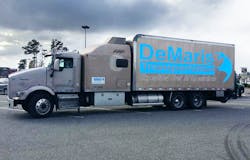Company: DeMaris Transportation, Cincinnati, OH
Operation: Expedited carrier providing 48-state service with a small fleet of straight trucks and cargo vans.
Problem:
Charles DeMaris started his expedited service business in 2007 with one truck and one driver—himself. “I got authority to book my own freight and had no thoughts of expanding, but within a year I had other drivers asking to sign on,” he says.
In fairly short order, DeMaris had to come off the road to manage what has now become a 37-truck fleet providing expedited carriage for the fleet’s own direct customers as well as brokered loads from larger carriers.
“When I was still on the road, I also needed to handle servicing customers and answering driver questions quickly,” DeMaris says. Automating the fleet’s business process and moving to a largely paperless environment seemed like the answer.
The solution DeMaris devised started with an iPad for himself and tablets or smartphones for the other drivers. Using the publicly available document storage service Dropbox allowed him to electronically swap documents that could be remotely accessed by everyone with proper permission to sign into the accounts he set up.
With his business continuing to grow, DeMaris had a workable paperless document system in place and the ability to quickly access or send those documents to customers and drivers. But managing the fleet’s operations was still a bit “fly by night,” he says.
Solution:
In 2009, with his fleet expanding quickly and looking for more loads, DeMaris had begun using a no-cost, web-based loadboard service run by Sylectus Software. The company also offered a “pro level” product that provided a range of integrated management tools and not only looked like the low-investment but full-featured transportation management system (TMS) he needed, but also fit well with DeMaris’s paperless approach. He knew he didn’t have the operating capital to support a big back office, but he also knew he needed to compete with larger carriers that did. So in early 2013, he signed on for the upgraded service.
Like most modern TMS, Sylectus “pretty much does everything from accounting to payroll to management reports,” he says. More important, it offers separate web- and app-based portals for drivers and customers that allow DeMaris to run his business from anywhere using just his iPad.
“I can convert an invoice directly into a PDF and email it to the customer, or call up driver pay reports or customer freight records,” DeMaris says. “I can do just about everything I need to do on the iPad. And I’m really just starting to learn how to use it. There’s a lot more to learn.”
On the productivity side of the equation, the system’s tracking and location functions have allowed the company to automate delivery updates to customers as well as driver status reports. “That frees up my dispatch so they can book more loads instead of spending time taking calls,” DeMaris says.
While most of his drivers already carry smartphones, DeMaris provides them for those who don’t so they can also plug into the system. Not only does that allow for more automated dispatch, but there are also a large number of applications the drivers can download to help make their jobs easier. For example, carrying handheld smart devices has even improved the fleet’s maintenance program, he says. “They can use the phone to record any problems when they do their inspections, and an imaging app coverts it to a PDF, which gets sent to our maintenance management system,” he says.
With much of his fleet management moving from “fly by night” to big-fleet efficient, DeMaris is already looking at other ways to expand his business with another Sylectus feature, its loadboard. “My next goal is to get a brokerage operation in place,” he says. “Today, a manufacturer’s main concern is that they want all of their freight covered. If you can’t cover one load, you won’t get another call from them.”
About the Author
Jim Mele
Jim Mele is a former longtime editor-in-chief of FleetOwner. He joined the magazine in 1986 and served as chief editor from 1999 to 2017.
